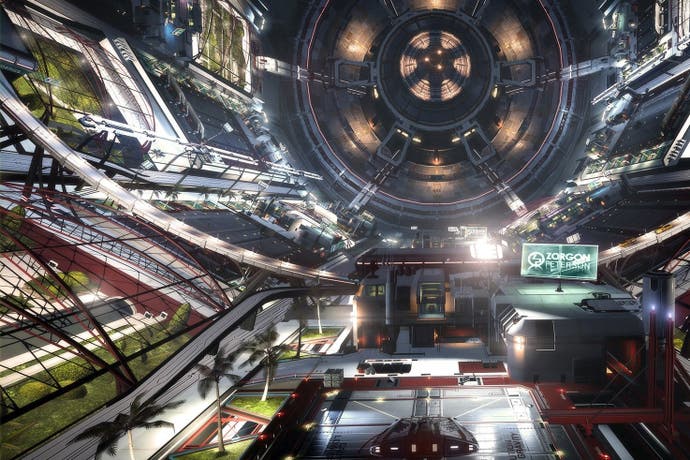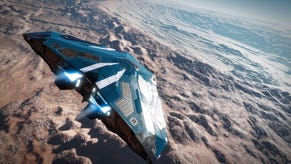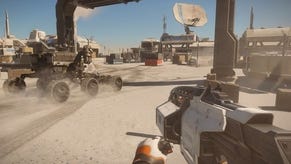Elite: Dangerous and the art of the galactic grind
How Frontier's long-awaited space sim is trying to balance commerce and conflict for a new generation.
Elite was the first game I ever dreamed about. It was a recurring dream, the sort of woozy loop of mental debris that stubbornly lodges in your mind for nights on end. In the dream, I was forever spiralling slowly towards the rotating white outline of a rectangle in an ink black void.
Every time, as I got within touching distance of the rectangle, I'd be out of sync with its rotation and the dream would reset, starting the whole claustrophobic descent all over again.
You may not have had the same dream, but if you played Elite back in 1984 you'll certainly have shared the same problem. I was dreaming about docking with one of the geometrically shaped space stations on David Braben and Ian Bell's seminal space simulation, a basic manoeuvre that immediately separated those doomed to remain ranked Harmless from those who might one day attain the illustrious ranking of the game's title.
Docking in Elite was hard, but then life in Elite was hard. Mastering the art of matching your rotation to that of the station then gently powering through that enormous letterbox slot to safely unload your cargo, restock and blast off into the vacuum was a rite of passage. Those that mastered it quickly learned that a docking computer to automate this fiddly feat should be at the top of any aspiring space captain's shopping list.

It was a rite of passage I was wary of repeating for Elite: Dangerous, a game which by all accounts took the already fairly complex original plus the more robust trading and Newtonian physics introduced in its 1990s sequels and then yanked the dial harder in the direction of hardcore simulation. I was pretty sure I'd spend my first few days in Dangerous slamming into space stations over and over, just like my childhood dreams.
Surprisingly, the first time I attempt a space station docking, I slip right in. Partly, this is down to the fully realised world that Elite now encompasses. No longer are you aiming at an abstract white shape in a sea of black, but a tangible opening in a physical structure, the dimensions and distance of which are immediately apparent. The perfectionism demanded in the 1980s is no longer a factor. You can wriggle through with a few scrapes, or you can swoop in with balletic grace, and the result is more or less the same.
Elsewhere, the evolution of Elite: Dangerous is harder to pin down. Gameplay still revolves around hyperspace hops from one system to another, trading cargo ranging from common goods to illegal contraband, taking on missions and deliveries, and fending off attacks from pirates - or the law, depending on how far over the line you wander in your quest for credits.
Elite was always a critique of capitalism, and that obsession with earning credits remains the spine of Dangerous. For the beginner, it's a steep slope that can feel a lot like a grind. Your starting ship, a basic Sidewinder, is free, but comes with a simple pulse laser that is only vaguely useful in a real combat situation, and a paltry four-slot cargo bay. The road to a better ship that can handle improved equipment means taking on a lot of missions, and hopping back and forth between the same reliable stations.
What's different this time is the sheer scale. Frontier (the Elite 2 sequel, not the studio) introduced a somewhat flaky autopilot to get you from your hyperspace drop point to your actual destination, but there's no such luxury for newbies in Dangerous. Here, you must first set your target system and blaze through hyperspace to get there. You exit hyperspace in a state called "supercruise" - essentially a midway speed that allows you to cover vast distances between planets.

If anything will bring back those docking nightmares, it'll be supercruise. Mastering this function is essential to efficient play, but also requires a lot of skill. Decelerate too soon and you'll find yourself drifting for ages to get to where you're going without firing up the Frame Shift Drive to give you another kick up the bum. Decelerate too late, however, and you'll zoom past your target in the blink of an eye.
Perhaps most controversially, it's while in supercruise that you are vulnerable to an interdiction. This is an attack from another vessel - sometimes an NPC, more often another player - that has equipped a device that allows a ship to be yanked out of supercruise. This not only sends you spinning out of control, it also overheats your ship's systems. You can flee an interdiction by keeping your flailing ship pointed towards a highlighted escape vector, but it's still an incredibly frustrating experience for new players.
Debate about interdictions, and the impact they have on the game, is still raging on the various Elite forums. On the one hand, they're seen as essential to prevent those long cross-system hauls from becoming tiresome. On the other, when all you have to your name is a piss-weak Sidewinder that is hilariously ill-equipped for combat, you have fertile territory for the deep space equivalent of griefers and campers to spend many hours picking off newcomers as they head into the more popular stations.
The systems begin to balance each other out as you acquire a better ship, with weapons that can actually put up a fight, but it makes for a fairly unwelcoming introduction to the game, and puts an undue emphasis on getting conflict-ready in the early going rather than exploration and trading.
Indeed, trading seems to have taken a back seat in recent updates, with stock levels and prices seemingly nerfed. Commerce was never the sexiest aspect of Elite, but it was always the core of the integral choice-based gameplay. Do you carry drugs and slaves, or food and textiles? That decision isn't as important as it once was, as you're unlikely to make a living in either - even with a hefty freighter at your disposal. It's far easier - and quicker - to rake in thousands of credits by undertaking missions, ranging from simple timed deliveries to assassinations. It's just one of a series of balancing decisions that will either delight or horrify those with strong feelings about where Elite's focus should lie.

Wherever that focus points come release day, and in the inevitable post-launch updates, Elite's fans will certainly be smitten with how the game looks. I even went so far as to load up the Spectrum version on my old +2, next to my PC monitor, and while the gulf in terms of visuals was enormous, there was also a very definite sense of continuity. Not just in the iconic circular central radar, but sleek, flat ship designs, the texture and feel of those cockpit interiors.
Couple that with astonishing attention to detail in what happens outside of the cockpit, as planets and moons go from specks to filling your view, and as you skim close enough to the surface of a star to see the solar flares curling past your canopy, and you've got a game that is designed to stun. This is, more or less, the version of Elite that my imagination had to fill in for me thirty years ago.
As it comes to the end of its protracted Early Access period, there are still aspects I'm unsure about, but most of my misgivings, I suspect, stem from half-remembered notions of what Elite is supposed to be rather than the pragmatic reality of what it actually is. I find myself worrying about the long game - something that never occurred to 11-year-old me - and whether those long haul flights will lose their lustre after hundreds of jaunts. Elite was phenomenal back in 1984, but we were much easier to please and impress back then. Now that we come to a game like this expecting rich world-building and ever more freedom of choice, will life as a space pilot still hold the same allure?
I suspect it will. The game has kept my attention so far, and it's often so gorgeous to look at that I find myself tooling around an unexplored system just to see what the planets look like as they roll past. It's changed a lot, and yet in so many ways it's hardly changed at all. Quite honestly, I'm still not sure how I feel about that.
I'm also unconvinced that the multiplayer aspect and the "shared universe" conceit is vital enough to the experience to justify the newb-trolling bandits and lack of offline play, but that frontier will come after December 16th, when the game is finally, officially on sale for all to play, not just the dedicated hardcore. For now, I realise I'm playing a new Elite game in 2014 and pinch myself. This dream, at least, came true.
This is an early impressions piece based on time with the near-final Gamma build of Elite: Dangerous. Our review of the finished game will be live early next week.









